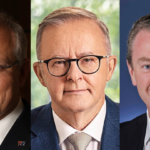The Incremental Gifting of Australian Military Control to the United States Is Alive and Well

Veteran journalist Brian Toohey outlines in 2019’s Secret that US intelligence agents weren’t too keen on then Australian prime minister Gough Whitlam’s mid-1970s questioning of the viability of US government operations at local military installations at Pine Gap and North West Cape.
But the legendary Labor leader must be in a continual spin in his grave ever since current party leader, Anthony Albanese, appeared in San Diego, standing beside US president Joe Biden, in March, to lay out the details of the AUKUS submarine deal, with its cool $368 billion taxpayer price tag.
Indeed, after the plan’s unveiling, which includes going nuclear via submarine propulsion, there’s been an escalation in the gifting of sovereignty to Washington, whether that be via designating the nation a US domestic military source in law or embedding US analysts in our defence spying agency.
Then Coalition PM Scott Morrison dropped AUKUS – an Indo Pacific security alliance with the US and the UK that targets China as aggressor – on our nation in 2021. And this occurred with no prior warning or consultation, despite it involving the acquisition of eight attack submarines.
So, when federal Labor took office in May 2022, there was a slight hope of a pulling back on what the Coalition’s AUKUS deal was foreshadowing.
However, no one expected Albanese, a politician who cut his teeth in his party’s far left faction, was going to go full throttle on vassal state militarisation.
The star-spangled kangaroo
Former foreign minister Bob Carr lamented in a recent piece that it’s clear Australia is sinking “into the role of US territory, as much a dependency as Guam or Puerto Rico”, due to the concessions we’re making, whilst Washington ignores our ministerial pleas to release journalist Julian Assange.
As further evidence, Carr cites the late 2022 news that the US is building facilities to house six nuclear-capable B-52 bombers at the NT’s RAAF base Tindal, which Lowy Institute director Sam Roggeveen has suggested are being positioned there to target Beijing’s nuclear infrastructure.
In the latest edition of Australian Foreign Affairs, Roggeveen stresses the extremely sensitive nature of threatening another nation’s nuclear arsenal, and Carr posits that to be making such concessions as this, and being ignored on other diplomatic issues, indicates our growing US territorial status.
The B-52 issue led to a further revelation, when Australian defence secretary Greg Moriarty explained in February that Canberra’s complied with the US policy to neither confirm or deny the presence of nuclear warheads on platforms since the 1980s. And this will also apply to the B-52s.
And just to add some concrete symbolism to dwindling Australian sovereignty, when the United States launched its new warship USS Canberra in Sydney last month, our navy presented its US counterpart with a star-spangled kangaroo to adorn the ship that will be patrolling the Indo Pacific.
Blurring AUKUS details
To accompany the Albanese, Biden and UK PM Rishi Sunak AUKUS announcement in San Diego, the White House released a fact sheet, so that constituents within the English-speaking security pact regions would sort of be aware of what’s in store, as no one consulted them in the first place.
Key points for our nation are that we’re investing somewhere between $368 to $450 billion in the US, UK and Australian war industries, and in return, we’ll be decked out with eight nuclear-propelled submarines that are capable of sneaking up on China and taking out its citizens on its mainland.
If Biden can gain congressional approval for our subs, they’ll start arriving in the 2030s, so, in the meantime, the Submarine Rotational Force-West will be established. This will involve four US and one UK nuclear-powered attack submarines being stationed on permanent rotation in WA by 2027.
The initial deal saw our nation first acquiring three US Virginia class submarines early next decade, and then building five newly designed AUKUS class submarines, with the UK’s assistance, in South Australia, over the next three decades.
Although most of the details around the Australian submarines have been repeatedly thrown into question since March.
The fact sheet also outlines that “as part of this commitment to nuclear stewardship, Australia has committed to managing all radioactive waste generated through its nuclear-powered submarine program, including spent nuclear fuel, in Australia”.
As Crikey recently pointed out, not only is the cost of the Australian nuclear waste dump yet to be discussed, but it also turns out the US and the UK have never constructed their own such installations, so a local version might be a fitting place for them to dispose of their own waste.
Increasing interoperability
Of course, as hinted at by the B-52s, the US has an on the ground military presence in Australia that goes beyond the military signals and communications facilities, like Pine Gap. And this was facilitated via an initial arrangement made between PM Julia Gillard and US president Barack Obama in 2011.
At that time, the US had determined to pivot its military might towards Asia and away from the destruction it had wrought in the Middle East, so that it could focus on surrounding and containing China, which was already threatening the US empire’s global economic hegemony.
The Abbott government went on to cement the terms of deal with the Obama administration in the 2014 Force Posture Agreement.
The force posture initiatives involve increasing interoperability between Australian and US air forces, via the stationing of a US presence over here, and it’s also seen a permanent rotational force of US marines in the Northern Territory, which now consists of 2,500 military personnel.
The FPA further provides the US with unimpeded access to numerous local military bases, and when Washington decides to upgrade one, the US military takes complete control of it, which is the case with RAAF base Tindal. And the list of which facilities this involves has never been released.
So, rather than the coming US submarine presence in WA being a new development, it simply builds upon the interoperability between the two nations’ “defence” forces.
And at last year’s AUSMIN, an annual meeting of Australian and US defence and foreign ministers, Japan, an increasingly important ally in the buildup to war against China, was invited to join these initiatives already operating on Australian soil.
Recruiting cannon fodder
Following the recent AUSMIN meeting in Brisbane, not only did the ministers announce that US military analysts will soon be embedded in the Defence Intelligence Organisation (DIO), but we’ve also agreed to start producing guided missiles for export to the US within the next two years.
With the release of the Defence Strategy Review 2023 in April, defence minister Richard Marles outlined that we’ll be investing in “much longer range strike capability”, and added that investment will rise above the $270 billion decade-long spend on US military equipment the Coalition brokered.
This forbodes the growing prioritisation of military spending over the social sector, which US citizens are well versed in.
As Greens Senator David Shoebridge told Sydney Criminal Lawyers in May, after the March AUKUS announcement, opposition leader Peter Dutton said he’d be happy to cut NDIS spending, disability supports, to help finance AUKUS, and Albanese went ahead and did just that at budget time.
And the US empire not only expects our nation’s military to become increasingly incorporated into its own, but, as per usual, Washington will also be demanding that fresh young Australian lives will be put on the line.
So, in order to ensure these extra Australian bodies are on hand, federal Labor launched ADF Careers last month, which consists of an overhaul and rebranding ADF recruitment.
The new system provides young people with a one-stop-shop to sign up to the army, the air force or the navy. And this development includes ADF Careers partnering with Swiss-French recruitment company ADECCO to help lure prospective soldiers into signing up.
“Today marks a new beginning for ADF Careers,” said defence personnel minister Matt Keogh on 19 July. “We have a new approach, a new brand, a new partner in ADECCO and a huge mountain to climb: to grow the permanent ADF to almost 80,000 personnel by 2040.”
“That’s a 30 percent increase on today.”







